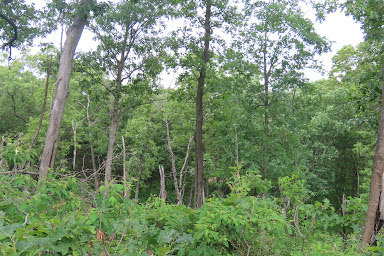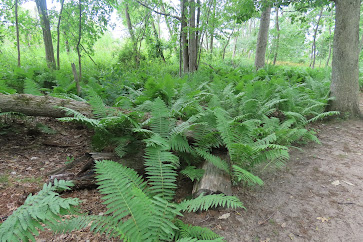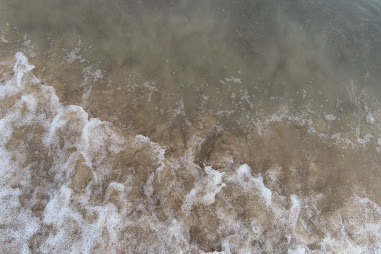Dune Ridge Trail
Indiana Dunes National Park
June 24, 2021
Dune Ridge, as seen from Kemil Beach
It's been a long, weird time, this pandemic period.
We've all experienced it in so many ways, some ways that we all have in common, some unique, and everything in between.
I thought I'd keep up with writing, and this blog, during that time. But that was one of those many things that did not happen.
Unique times, though, especially those that keep people in more isolation than usual, create space for more introspection, more observation, more writing-in-the-head. And that's valuable stuff.
Here is the short trip my husband and I made to the Indiana Dunes in late June. This was symbolic in many ways. It was the first “long” (longer than a day) trip we had taken since the pandemic started. It was the first time we had gotten up to northwest Indiana (from our opposite end of the state) in an even longer time. It was the first time we had seen my Dad in person in about sixteen months.
And, it was the first time for me to do something I had been needing for some time – to get farther away from the crowding of responsibility, from intensity, from people wanting this-and-that, from the frustrations of not being able to achieve certain goals. Finally, here was an opportunity to just let it all go to the sky, the waves, the sand, to let it all dissipate so that there could be space for the fresh perspective I needed.
And, so, here I am again.
I'm not ready for the Big Opening that has been happening all too soon – the crowds, the noise, the intense activity, the boisterousness.
But, I am ready to share my experiences, observations, and musing again, in this quiet way.
Part 1
Here we go, on the Dune Ridge Trail.
Dune Ridge Trail is part of the Indiana Dunes National Park (the last time we were at the Dunes, it was still Indiana Dunes National Lakeshore, which had been established in 1966). I think this is a fairly new trail, but I'm not sure. It's a really short one, only .6 miles, according to park information (some other sources have given other figures). But, parts of it are on steeply sloped sand (“two steps forward, one step back”). And, this little trail goes through a number of different interesting ecosystems for being so short, and affords a magnificent view along part of it.
The above photo is the start of the trail. Here we are in the foredunes – the ecosystem just behind the beach. Marram Grass (Ammophila arenaria) is predominant, spreading by sturdy rhizomes underground that can anchor into the sand, and that also send up new grass shoots. These anchoring roots hold sand in place, providing stability for other plants to take root, such as young Cottonwood trees (Populus deltoides). On the right is a blue-green spot – that's Wormwood (Artimesia absinthium). It's not a native plant here. It's from Great Britain, and was brought here because of its medicinal value, then it took off and readily naturalized in places like this.
To the left is a blackened shrub. I don't know what kind it was. But, this is an introduction to the fact that this is one of many places in the Dunes where prescribed burns are done, which keeps these places in diverse vegetation.
And, ahead you see the edge of the forest. Let's go!
A little way in, and we started seeing a sparse population of Bracken Fern (Pteridium aquilinum latiusculum).
Now we are getting into a more wooded area, where we start encountering my favorite flower of the Dunes – Hairy Puccoon (Lithospermum canescens). It's such a vibrant, unique yellow, and I love when it appears in large groups. This one is framed by a Bracken Fern, as if in a purposeful arrangement for a vase. To its left is a very young Black Oak tree (Quercus velutina). We are entering a Black Oak savanna.
By the way, when you start on the trail it goes forward a bit, then T's off. At that point you can go left or right onto the “lollipop” loop trail. Walkers just returning told us that there's more steep upward climbing if you start on the right, so we started to the left. I just wasn't up to it that day, physically.
Another common plant in the Dunes – Common Milkweed (Asclepius syriaca) with its sweetly aromatic blooms. The leaves are important food for the Monarch caterpillars, but many species feast on the nectar of the blossoms. Seeing these, I am reminded of hiking a sandy wooded trail here with my family when I was very young, and we found ourselves in the middle of a large migration of Monarch butterflies sweeping through.
Richard along the trail, heading into the woodland part of the ridge, on firmer soil that contains more organic matter.
Blueberries!! I'm not sure which species, though, due to the roundish leaves. Maybe Hillside Blueberry (Vaccinum pallidum)? And to its left is another kind of Oak seedling – White Oak (Quercus alba).
Ah! Here we are, in the Black Oak savanna!! Possibly my favorite ecosystem. A Black Oak savanna is predominantly, of course, Black Oak trees, but instead of having an under-story of varying heights of shrubs and other plants, it has a mass of low vegetation (in some places, this is primarily grasses, but not here). There's a special feeling that comes over me in a Black Oak savanna, likely because of my fond memories of wandering this ecosystem in the area behind the neighborhood where I grew up. It does have a special quality of light, and then there's the contrast between the dark, vertical tree trunks and the open, green area below.
There were also American Witch Hazel shrubs (Hamamelis virginiana ) along this trail.
Prairie Roses (Rosa arkansana suffulta) appeared here and there, decorating the sunny trail sides in various hues of pink. They are also popular with various insects – you can see a couple of tiny black beetles on this one.
Ahhh, don't you just love this scene? Getting higher up the trail, and it's sandy again (closer to the edge of the ridge). This is a steep section, and it's full of Oak saplings, young Sassafras trees (Sassafras albidum) and Staghorn Sumac shrubs (Rhus typhina).
This sounds delicious! Oaks produce acorns, a good source of protein. Sassafras has a wonderful, unique scent and flavor throughout the whole tree, and you can make tea from the bark of the roots or just chew on a leaf stem while walking. Staghorn Sumac produces upright, cone-shaped clusters of tightly packed, fuzzy magenta berries. You can steep them for a kind of “lemonade”.
And now we come upon another kind of Milkweed, the gorgeous Butterfly Weed (Asclepius tuberosa)! Stunning, isn't it? And there are large groups of them along the trail sides! This is a wonderful native plant to add to your garden or landscape to attract all sorts of butterflies and other pollinators, and also, like the Common Milkweed we saw earlier, to feed the caterpillars of Monarch butterflies.
Getting near the top of the ridge!
Here we can see the three-lobed leaves of Grape vines decorating the vegetation on the left, from bottom to almost the top. On the right we can see the many-fingered compound leaves of Staghorn Sumac.
And here's a close look at that Staghorn Sumac (Rhus typhina), with the fuzzy fruiting clusters. Their color really brings out the lovely magenta stems, too.
Up, up … to the top, and ...
Wow!! We are rewarded with this wonderful view of the Great Marsh, stretching out below.
What a great habitat! Stay here awhile with a pair of binoculars. You are bound to see various kinds of birds and other wildlife.
Views panning from right to left:
There are a number of other trails and places to view parts of the Great Marsh in both the Indiana Dunes State Park and Indiana Dunes National Park properties. The Great Marsh Trail, east of this one, has a really nice viewing area. Trails 2 and 10 in the State Park take you close to both sides. Cowles Bog Trail is another great place to see this ecosystem (which is, technically a fen).
To learn more about the Great Marsh at the Indiana Dunes and how it was formed, scroll back to earlier posts in this Terri of the Trails blog.
A closer look at the leaves of two species of trees predominant on the Dune Ridge Trail: Black Oak (top) and Sassafras (bottom).
Surely this is used as a perch by hawks, owls, and a number of other kinds of birds. It's a good, high spot to survey the area.
We come upon another plant common in the Indiana Dunes – Blue Lupine (Lupinus perennis). We are past the time for seeing the beautiful spikes of blue flowers of this legume. We can see the gray-brown seed pods which are curled, signifying that they've already flung the seeds far from the plant.
Behind the Lupine is a small patch of Poison Ivy (Toxicodendron radicans). A native plant, it is important for providing food and shelter to native wildlife, and turns brilliant red in autumn.
Bracken Ferns
Very sandy trail with mostly under-story vegetation – ferns, shrubs, tree saplings.
Another peek at the Great Marsh as we head back toward the wooded area.
Spiderworts decorate trail edges with their elegant leaves, drooping clusters of flower buds, and cornflower blue blossoms. I am not sure what species this is – maybe Ohio Spiderwort (Tradescantia ohiensis)?
Back into the Black Oak Savanna. You see how the ecosystems change quite a bit along this short trail! You can also see some burned spots, like the charred stump in the second photo, left from the latest prescribed burn. And you can see how lush the vegetation is, aided by those burns.
Looks like a grove of Cinnamon Ferns (Osmunda cinnamonomea) in the under-story here. Let's take a closer look …
A bit like being in a primeval forest.
Moving right along through the Black Oak savanna …
A lovely array of Black-eyed Susans (Rudbeckia hirta). I'm not sure what the other plants are around it, but those are beautiful leaves.
A new plant for my vocabulary:
Long-headed Thimbleweed (Anemone cylindrica), with a fading bloom and developing seed heads.
It looks like insects have been feasting on the Black Oak leaves behind it.
On our way through the last of the Black Oak savanna for this walk …
… then on to the end of the trail, into the bright light, back to the thick sand of the foredunes.
Part 2
After stopping at the car to exchange “hiking things” for “beach things”, we took the short section of road down to Kemil Beach. We saw a number of different Indiana Dunes plants along the way, growing in the thick, loose sand:
Fragrant Sumac (Rhus aromatica) has clusters of fuzzy, cherry-red fruits, looking like cherries dipped in sugar. Like cherries (though not at all related), each fruit contains a single “stone” seed. Climbing the shrub is Riverbank Grape (Vitis riparia). The leaves feed many types of insects, and various kinds of birds and mammals eat the dark blue fruit. The groups of three leaflets look something like those of Poison Ivy, but are not toxic. In fact, this shrub is used as an ornamental in yard and urban landscapes.
On our way down to Lake Michigan and the beach, Richard stops to look at …
… A Hop Tree (Ptelea trifoliata). Also called Wafer Ash (due to the look of the winged fruits, like some Ash seeds), it is in the Citrus family, and is scented. The name Hop Tree refers to the fruit being once used as a substitute for hops in beer-making.
Part 3
And now, down to Kemil Beach and the shores of Lake Michigan.
This is one of my favorite kinds of scenes that I keep close to me in my mind's eye always.
Enjoy the scenery:
Ring-billed Gulls are common here (Larus delawarensis) …
… but on this day I made acquaintance with a bird I didn't know, an Eastern Willet (Tringa semipalmata). This bird leaves the U.S in winter for Central and South America.
I first noticed it when it flew over the lake, and over the beach, to land right next to the water. It has a very distinctive black and white pattern that stands out in flight …
… but that disappears when it lands and folds its wings.
Dark clouds had been gathering, getting darker. The wind picked up, and the waves became more prominent, louder, higher. There was a scattering of rain now and then, but eventually it became more steady.
We picked up our things and headed back over the sand, up the foredune, and up the stretch of road to the car. Then, the rain fell in earnest and did not stop the rest of the evening, the night, and the next day, as we headed south toward home.
More memories made, added to those I've had ever since I was a young child, coming here.
More yearning to come back again.
I had given my frustrations to the lake breeze, let them dissipate over the sand, waves, and the horizon of varied and changing blues.
Artist working at the Great Marsh.
More on the Dune Ridge Trail:
http://www.nps.gov/indu/planyourvisit/dr16.htm#CP_JUMP_5034622
Map, short description, photos – foredune complex (Marram Grass, Little Bluestem Grass, Cottonwood trees), oak savanna, Great Marsh views.
Https://digthedunes.com/dunes-ridge-trail-at-kemil-beach
Posted in 2013
https://americantraveljournal.blogspot.com/2020/11/dune-ridge-trail-indiana-dunes-national.html
A walk on the whole trail in autumn.
Virtual Ranger Hike with J.P. Anderson in April, 2020: learn about Dunes plant succession, migrating birds, prescribed burns, Great Marsh, frogs, trees.





































































No comments:
Post a Comment